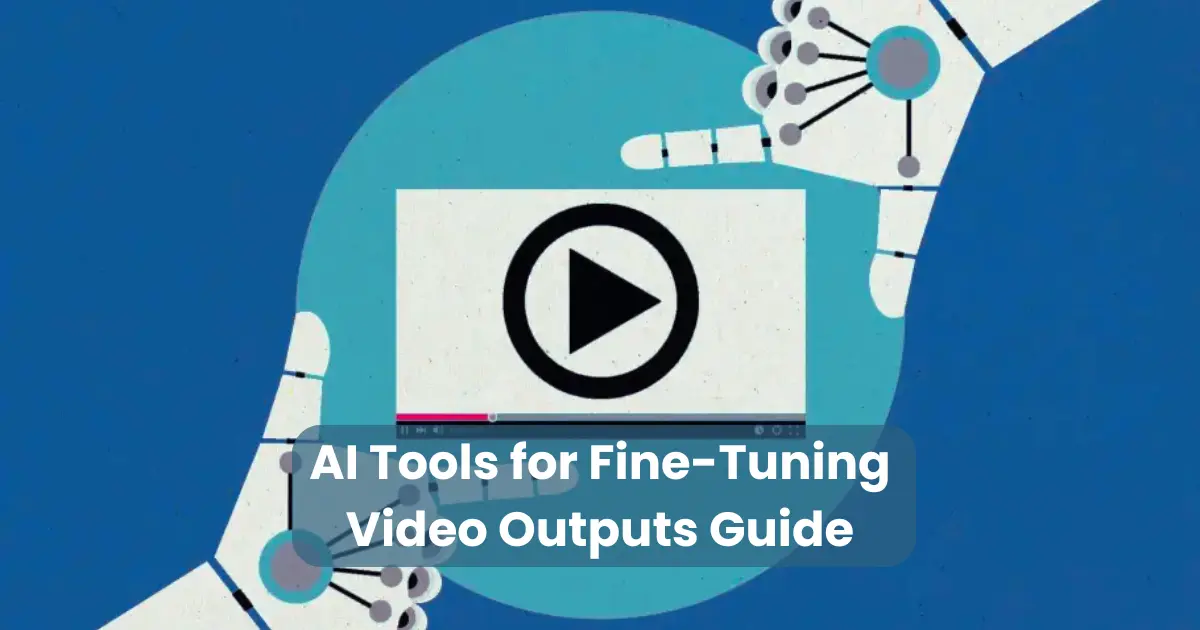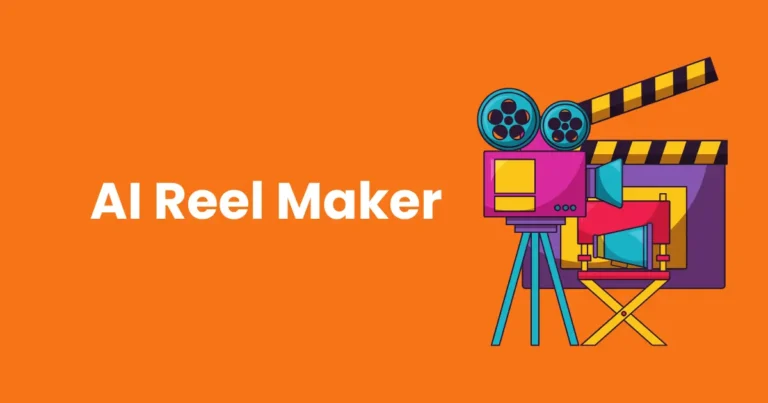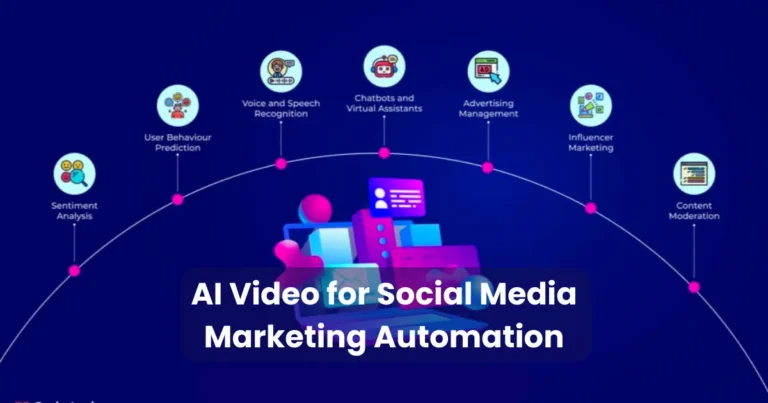AI Tools for Fine-Tuning Video Outputs Guide

Contents
In today’s fast-paced digital world, producing high-quality videos isn’t just a bonus—it’s a requirement. Whether you’re a content creator, marketer, or production house, having access to a reliable AI tools for fine-tuning video outputs guide can be a game-changer. These intelligent solutions enable users to polish raw footage, correct visual flaws, and optimize final renders without spending countless hours on manual edits.
As artificial intelligence continues to revolutionize video production, editors now benefit from powerful algorithms that enhance resolution, reduce noise, and even auto-color grade in seconds. By integrating these tools into your workflow, you can save time, increase output quality, and maintain creative control. In this guide, we’ll walk you through the best AI platforms available, key features to look for, and practical tips to help you achieve studio-grade results—fast and efficiently.
Why Fine-Tuning Video Outputs Matters
Before diving deep into the AI tools for fine-tuning video outputs guide, it’s essential to understand why this process is so critical. In a saturated media environment, where audiences scroll past content in seconds, video quality can make or break engagement. Clear visuals, smooth transitions, and balanced audio aren’t just aesthetic perks—they are fundamental to viewer retention and brand credibility.
Moreover, raw footage often contains imperfections like shaky frames, poor lighting, background noise, or inconsistent color grading. Without fine-tuning, these flaws can distract viewers or reduce the overall impact of your message. That’s where AI comes in—transforming average shots into professional-grade visuals with minimal effort.
Fine-tuning ensures your videos look polished across all platforms, from mobile screens to 4K monitors. It helps maintain consistency in branding, improves storytelling, and saves you time by automating tedious corrections. As this AI tools for fine-tuning video outputs guide will show, the right tools can elevate your content to new heights, keeping you competitive in an increasingly visual digital world.
Top AI Tools for Fine-Tuning Video Outputs
Choosing the right platform is crucial to getting the most from this AI tools for fine-tuning video outputs guide. Below, we break down some of the most powerful and user-friendly AI tools available today. Each one brings unique capabilities to the table, enabling creators to enhance video quality quickly and with professional results.

1. Adobe Sensei (via Premiere Pro & After Effects)
Adobe Sensei uses artificial intelligence to automate time-consuming editing tasks. Features like auto-reframe, scene edit detection, and AI-powered color grading streamline workflows while preserving creative control. It’s deeply integrated into Adobe Creative Cloud, making it a perfect match for editors already in that ecosystem.
2. Runway ML
Runway ML is a browser-based platform known for its accessibility and AI-powered editing modules. It allows users to perform tasks such as background removal, object isolation, motion tracking, and color enhancements—all without needing to code. It’s ideal for content creators who want quick results without sacrificing quality.
3. Topaz Video AI
Topaz Labs delivers high-performance upscaling and restoration features through Topaz Video AI. Whether you’re working with grainy SD footage or older digital files, this tool uses machine learning to sharpen details, reduce noise, and increase resolution up to 8K. It’s one of the most precise options in this AI tools for fine-tuning video outputs guide.
4. Pika Labs
Pika Labs focuses on creating AI-generated video effects and seamless transitions. Its intuitive UI makes it easy for both beginners and advanced users to fine-tune stylistic elements. With a growing library of templates and motion presets, Pika Labs helps bring creativity to life with minimal effort.
5. DaVinci Resolve with Neural Engine
DaVinci Resolve is a favorite among colorists and post-production professionals. The built-in Neural Engine adds smart tools like facial recognition, speed warp, object removal, and auto-color matching. It combines industry-grade features with AI efficiency, making it a top recommendation in this AI tools for fine-tuning video outputs guide.
These tools cater to a range of editing needs—from quick enhancements to full-scale cinematic production. As you explore each one, focus on how they fit into your workflow and what kind of quality improvements they offer. In the next section, we’ll cover the must-have features you should look for in any AI video editing tool.
Key Features to Look For in AI Video Tools
When choosing the right solution from this AI tools for fine-tuning video outputs guide, it’s important to focus on the features that truly enhance your workflow and final output. Not all AI tools are built the same—some prioritize automation, while others offer detailed control. Here are the must-have features you should consider:

1. Smart Color Grading
AI-powered color correction tools help match tones across clips, balance highlights and shadows, and apply consistent looks. This feature is essential for creating a unified visual style and maintaining professional aesthetics throughout your video.
2. Noise Reduction and Upscaling
High-quality tools use AI to reduce grain, eliminate motion blur, and upscale lower-resolution videos to 4K or even 8K. These enhancements not only improve clarity but also extend the usability of older or low-quality footage.
3. Auto-Cut and Scene Detection
Many AI editors can now detect scene changes, auto-cut transitions, and remove dead space or awkward pauses. This saves a significant amount of time during the editing process, allowing you to focus more on storytelling.
4. Object and Background Removal
Advanced AI tools for fine-tuning video outputs guide users in effortlessly isolating subjects or replacing backgrounds. This is especially useful for product videos, green screen footage, and creating visual effects without extensive manual rotoscoping.
5. Real-Time Rendering and Preview
Speed is key. The best AI video tools provide real-time previews and rendering, so you can see the effects of your changes immediately. This feature keeps the editing process smooth and efficient.
6. Facial Recognition and Retouching
Facial recognition helps track subjects, apply beauty filters, and stabilize head movement. It’s a valuable asset for interviews, vlogs, and any video featuring people prominently.
7. Integration with Editing Suites
Finally, ensure the tool you choose integrates well with your primary editing software. Whether it’s Adobe Premiere, Final Cut, or DaVinci Resolve, seamless integration prevents compatibility issues and speeds up production.
With these key features in mind, you’ll be better equipped to evaluate and select the right solution from any AI tools for fine-tuning video outputs guide. In the next section, we’ll walk you through how to use these tools step-by-step for professional results.
Step-by-Step Workflow for Video Output Enhancement
To get the most out of this AI tools for fine-tuning video outputs guide, it’s important to follow a streamlined workflow. Whether you’re working on short-form content or a full-length production, these steps will help you transform raw footage into high-quality, polished videos using AI.

1: Import and Organize Your Footage
Start by importing all your raw video files into your editing environment. Use bins, folders, or tags to categorize scenes, audio, and visual assets. Good organization sets the foundation for a smoother editing process.
2: Preprocess with AI Noise and Blur Reduction
Next, run your footage through an AI tool like Topaz Video AI or DaVinci Resolve’s Neural Engine to reduce noise and correct blur. This step improves clarity and prepares your video for further enhancement.
3: Auto-Detect Scenes and Cut with AI
Use tools like Adobe Sensei or Runway ML to detect scene changes and create intelligent cuts. This not only saves time but also ensures smoother transitions and better pacing throughout your content.
4: Enhance Visuals with AI Color Grading
Apply AI-driven color grading to unify the look of your project. Most tools in this AI tools for fine-tuning video outputs guide offer one-click presets and smart suggestions based on lighting, scene type, and mood. Always preview the results and fine-tune for consistency.
5: Refine Audio and Sync
AI can also enhance your audio. Tools like Descript or Adobe Audition use AI to remove background noise, correct pitch, and even sync voiceovers automatically. Clean audio is just as important as crisp visuals.
6: Add Effects and Final Touches
Now’s the time to apply motion graphics, transitions, or background replacements using AI tools like Pika Labs or Runway ML. Make sure every element supports your story and doesn’t distract from it.
7: Export with Optimal Settings
Once satisfied, use AI-powered render settings to export your project in the best format for your target platform—whether it’s YouTube, Instagram, or a film festival submission. AI suggestions help balance file size and quality.
Following this workflow ensures you use each feature in the AI tools for fine-tuning video outputs guide effectively. It also minimizes human error and drastically cuts down production time, helping you deliver professional results at scale.
Tips to Maximize Output Quality Using AI
Even with the best tools, achieving top-tier video quality requires strategy. This AI tools for fine-tuning video outputs guide wouldn’t be complete without expert tips to help you squeeze every bit of performance out of your chosen software. Follow these recommendations to ensure your final videos look professional and polished.

1. Always Start with High-Quality Footage
While AI can fix many flaws, starting with decent footage gives you more control during editing. Good lighting, stable shots, and clear audio provide a strong foundation for enhancements.
2. Use Layered Enhancements Instead of One-Click Fixes
Although one-click features are tempting, layering smaller AI enhancements (like gradual color correction, subtle sharpening, and light denoising) creates a more natural result. Avoid over-processing, which can lead to artificial-looking footage.
3. Preview Frequently
Always use the preview option after each AI adjustment. Many AI tools for fine-tuning video outputs guide users by offering real-time previews—take advantage of this to catch issues before rendering.
4. Combine Multiple AI Tools When Necessary
Sometimes, one tool doesn’t do it all. You might use Topaz for upscaling, Adobe Sensei for color grading, and Runway ML for object removal. Combining strengths of different tools often yields the best results.
5. Customize Presets
Most AI platforms come with presets, but fine-tuning them based on your content type (e.g., interview, cinematic, vlog) leads to higher quality. Don’t settle for default settings—make them yours.
6. Calibrate for Platform Requirements
Before exporting, optimize settings based on the final platform. YouTube, Instagram, and broadcast TV all have different resolution, bitrate, and format needs. Many tools in this AI tools for fine-tuning video outputs guide include automatic export templates—use them!
7. Leverage AI for Audio Too
Don’t neglect audio quality. AI tools like Adobe Audition and Descript offer advanced voice cleaning, leveling, and background noise removal, which significantly enhance the viewing experience.
By applying these tips, you’ll get the most out of the techniques in this AI tools for fine-tuning video outputs guide. Up next, we’ll highlight common mistakes to avoid so you can sidestep the pitfalls and stay focused on creating standout content.
Common Mistakes to Avoid
While AI has revolutionized video editing, it’s still easy to make errors that can impact your final result. This AI tools for fine-tuning video outputs guide helps you recognize and avoid these common pitfalls so you can produce high-quality content consistently.

1. Relying Too Heavily on Automation
One major mistake is depending entirely on automated results. While AI speeds up the process, it’s not perfect. Always review and manually adjust outputs where needed. Blind trust in automation can lead to overexposed visuals or unnatural transitions.
2. Ignoring the Original Footage Quality
AI tools can enhance, but they can’t work miracles. Starting with poorly lit, shaky, or extremely noisy footage limits what AI can fix. Always capture the highest quality video possible before editing.
3. Overusing Effects and Filters
Another mistake is applying too many AI-powered filters or enhancements. This often leads to a synthetic or overprocessed look. Keep edits subtle and purposeful—less is often more.
4. Skipping Manual Review
Even if a tool offers real-time previews, some users skip detailed reviews before rendering. Always inspect your edits at full resolution before exporting. This small step avoids visual or audio glitches from slipping through.
5. Using Outdated Tools
New AI models are constantly being released. Using outdated software means missing out on improved features and better results. This AI tools for fine-tuning video outputs guide recommends updating your tools regularly to stay ahead.
6. Not Customizing Presets
Many editors apply presets without customizing them. However, default settings rarely suit every project. Modify AI presets to match your content’s tone, mood, and platform requirements.
7. Ignoring Platform-Specific Requirements
Finally, always consider where your video will be published. Export settings for YouTube, TikTok, or professional broadcast vary widely. AI tools often offer platform-based export templates—use them to your advantage.
By recognizing these common mistakes, you’ll avoid wasting time and ensure better results with every project. This AI tools for fine-tuning video outputs guide ensures you stay on track, delivering clean, professional videos every time.
Conclusion
Fine-tuning video content no longer requires hours of manual editing or expensive post-production services. With the right approach and this AI tools for fine-tuning video outputs guide, you now have the knowledge and resources to significantly boost your video quality using intelligent automation.
From color correction and audio cleanup to scene detection and visual effects, AI is transforming how creators produce polished, professional-grade videos. However, as you’ve seen, success isn’t just about picking the right tool—it’s about how you use it. By following a structured workflow, avoiding common mistakes, and applying smart enhancements, you’ll maximize both quality and efficiency.
Whether you’re an independent creator, a marketer, or part of a production team, embracing AI will elevate your editing process. Stay updated, experiment with different features, and always aim for quality over speed. This AI tools for fine-tuning video outputs guide is just the beginning—your creativity and smart tool usage will define the final result.






